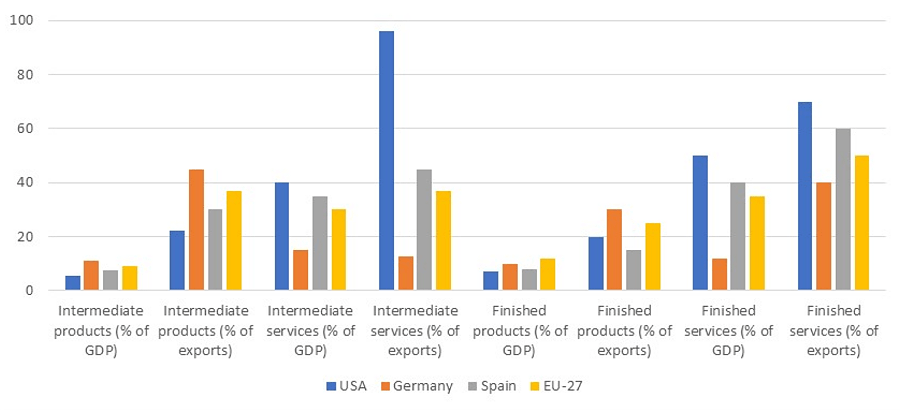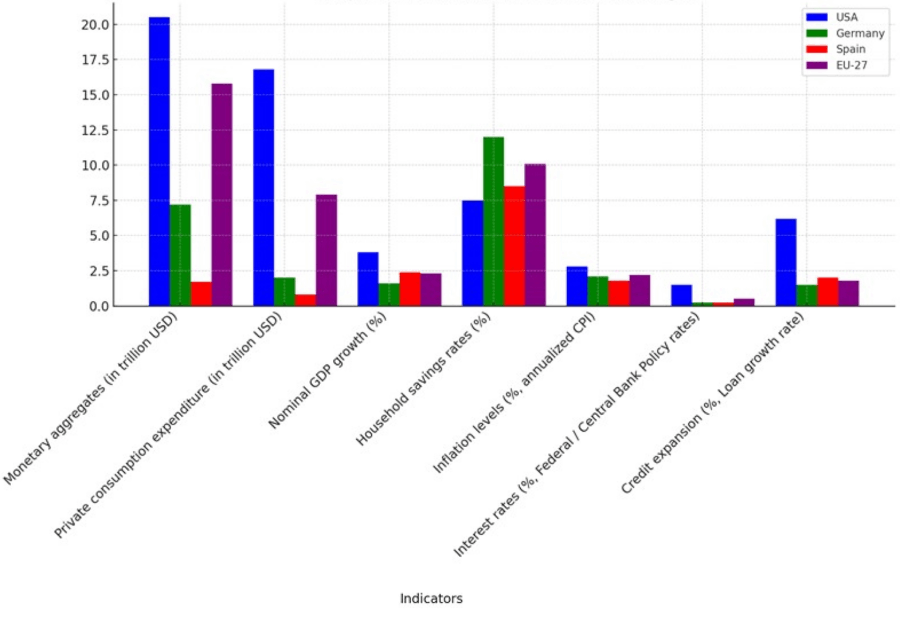Preamble
When a policy document like the “The Future of European Competitiveness” report (commonly referred to as the “Draghi Report”) is published, it is typical for various journalists and analysts to scrutinize its content.
Uncovering two pitfalls that could define the success of the Draghi report's proposals
While political commentators may focus on the usefulness and appropriateness of the proposed measures, economic analysts tend to concentrate on assessing whether the (cost-benefit) projections within the report are valid and credible. From a business perspective, a useful framework for evaluating the effectiveness of the aforementioned report is the VRIS model (Barney, 1991). This model helps determine whether the proposed measures are valuable and capable of generating positive effects, if the measures to be implemented or the effects to be produced are rare and difficult to imitate, and whether the anticipated benefits provide a sustainable advantage.
In the following analysis, I argue that the actions outlined in the Draghi Report may not fully pass the VRIS test. While the measures it proposes are undoubtedly valuable, they are neither rare nor difficult to imitate. Thus, implementing them would not lead to a sustainable advantage. In fact, if the United States were to implement similar measures (or allocate a competitiveness budget comparable to that proposed by Draghi), it would likely diminish the benefits Europe hopes to derive from the report’s recommendations. It is even plausible to think that if the United States adopted similar measures, the gap in technology, innovation, productivity, and prosperity between the United States and Europe would widen even further.
Introduction
On September 9, 2024, the report "The Future of European Competitiveness" was presented, highlighting the widening gap in technological innovation, productivity, and prosperity between the European Union (EU) and the United States of America (USA). To address this matter, the report proposes full implementation of the single market, supported by industrial, competition, and trade policies that are closely interconnected and aligned with a broader European competitiveness strategy.
While the proposals to complete the single market and strengthen support policies are necessary to boost Europe’s competitiveness, I question whether they will be sufficient to narrow the gaps in technology, productivity, and prosperity with the USA. In fact, I suggest that if the United States were to implement similar measures, it would likely derive greater benefits from them than the EU-27.
This conjecture is based on two structural elements in which the EU and USA differ: their 'economic specialization structures' and the 'private sector’s responsiveness to seminal public investments.' These factors shape each region’s ability to generate disruptive technologies, enhance productivity and prosperity, and leverage economies of scale within a common internal market. Below, I delve into each of these parameters to further explain my reasoning.
Economic specialization structure
There are several ways to characterize a country’s economic specialization structure. One approach is to categorize activities into primary, secondary, tertiary, and quaternary sectors. Another method involves breaking down economic activities using NACE codes. Additionally, the emphasis on economic activities that produce intermediate versus finished products and services can serve as a useful indicator.
If we use the latter approach to characterize an economy’s specialization structure, we can infer its relative propensity for generating disruptive innovations. Activities focused on intermediate products and services tend to produce more incremental innovations, while those centered on finished products and services are more likely to result in radical innovations.
The following cases illustrate examples of radical innovations:
- Tesla's Over-the-Air (OTA) Software Updates. Tesla revolutionized the automotive industry by introducing OTA updates, enabling vehicles to receive new features, enhance performance, and fix issues remotely, without requiring a service center visit. This innovation set new industry standards for vehicle maintenance and user experience, resulting in high user satisfaction and loyalty. Many other automakers have since adopted similar systems.
- New Business Models in the B2C (1) Transportation Market. New business models, such as ride-hailing, ridesharing, and pay-per-mile schemes, have emerged in the B2B (2) car and transportation market (e.g., Uber, Zipcar). However, this shift toward pay-per-use models has not extended to pay-per-use arrangements between car manufacturers and their suppliers in the upstream B2B segments of the value chain.
- Power-by-the-Hour in the B2B Aviation Market. In the B2B aviation market, aircraft turbine manufacturers use product-as-a-service payment models (e.g., "power-by-the-hour") with airline companies. However, this servitization approach is not mirrored upstream in the value chain, where companies supplying inputs for turbine construction are not subject to similar pay-per-use schemes.
In each of these cases, the origin of innovation lies in the supplier-user relationship for the final product or service, while upstream activities tend to exhibit incrementalism or maintain the status quo.
Consequently, economies more oriented towards end users (i.e., individual or corporate consumers) or with a higher concentration of activities geared towards final products and services are more likely to experience disruptive innovations (Coccia, 2017).
On the one hand, customers of intermediate products—typically B2B market buyers—are more cautious when adopting new technologies, often preferring proven solutions. Thus, while the production of intermediate goods may be R&D-intensive, it generally results in incremental rather than radical innovation. On the other hand, end consumers are often more willing to try new things or assume less risk in doing so. As a result, businesses focused on final products or services face stronger incentives for radical innovation. The subsequent disruptive changes may manifest not only as technological advances but also in the ways that products or services are consumed, used, or paid for—often through new business models.
Accordingly, economies driven by final products and services are more likely to become incubators for new markets, business lines, and economic growth. In other words, radical innovation facilitates the creation of new industries by fostering technologies and business models that respond to evolving customer and market needs, generating new market opportunities and reshaping the competitive landscape (Lettl et al., 2006).
Moreover, radical innovations often yield significant productivity gains and increased prosperity for economic agents. Typically, margins on final goods exceed those on intermediate goods, especially when value-added factors like branding, design, or other intangibles are involved (Hübscher and Martynkiewitz, 2021). These factors allow innovators to set higher prices by leveraging product differentiation, brand value, and customer experience (Kulp et al., 2004). Thus, productivity and prosperity tend to grow more robustly in economies focused on the production and trade of final goods.
Using calculations by the World Trade Organization based on OECD TiVA database figures, we can analyze the relative dependence of Germany, Spain, the EU-27, and the United States on intermediate versus finished goods and services, both in terms of GDP(3) contribution and exports. Doing so leads to the following results:
Figure 1.
Scores on economic specialization structure indicators

Main take-aways: (4)
The US economy is more service- and end-consumer-oriented than the EU-27 and its largest member state, Germany. While Spain is somewhat closer to the US in terms of final service provisions, this is largely due to its tourism sector. The USA, however, has a more diversified service economy, with notable strengths in financial, professional, and commercial services. This holds true for both intermediate and final service activities and exports. Also, US intermediate goods are largely service- and trade-based, supporting wholesale and retail activities, finance, and professional services.
When it comes to manufacturing, the situation is reversed: the USA lags behind the other three territories across all indicators. Whether we look at intermediate or final goods, the production of these goods as a percentage of GDP, or their share in total exports, the USA shows a lower proportion than Germany and the EU-27.
Germany stands out for its high percentage of intermediate goods in GDP and exports, reflecting its robust industrial base. Germany's intermediate goods primarily consist of physical and industrial inputs, such as machinery and vehicle parts.
- Germany stands out for its high percentage of intermediate goods in GDP and exports, reflecting its robust industrial base. Germany's intermediate goods primarily consist of physical and industrial inputs, such as machinery and vehicle parts.
- The U.S. shows a smaller proportion of GDP and exports linked to manufactured intermediate goods, as its economy is more service-oriented. U.S. intermediate goods are primarily service-based, including wholesale and retail trade, finance, and professional services.
- The EU-27 averages typically fall in between those of Germany and the USA, with a significant manufacturing reliance in Eastern European member states, while countries like France and Spain show a stronger orientation towards the tertiary sector.
- Finally, Spain has a slightly lower contribution of manufactured intermediate goods due to a greater focus on services.
Implications:
Given this analysis, the US economy is more likely to foster radical innovations—both technological and business model-wise. It is also positioned to capture higher margins linked to such innovations and create new markets. As a result, the USA may have an advantage in capitalizing on productivity and prosperity gains from policy support measures.
Private sector’s responsiveness to seminal public investments
A second key structural difference between the EU-27 and US economies is how the private sector responds to seminal investments by public actors. This factor directly affects the multiplier effects that public policy or investment can generate, not only among direct beneficiaries but also through the spending and investment of other economic actors.
To compare the European and American contexts, data from the OECD, the Federal Reserve, the European Central Bank, the Bureau of Economic Analysis, and Eurostat provide valuable insights. These data sources allow for calculating nominal GDP growth, monetary aggregates, household savings rates, private consumption spending, inflation levels, interest rates, and credit expansion. An analysis of these indicators reveals notable differences between the USA and the EU-27 during the period 2019-2023:
Figure 2.
Scores on indicators related to private sector's responsiveness to seminal public investments
Main take-aways:
- US Economy: Higher private consumption, lower savings rates, and relatively strong nominal GDP growth. Moreover, the recent expansion of money supply has facilitated private spending, reinforcing the US’ consumer-oriented economy.
- EU-27 Economies: Generally higher savings rates and more conservative spending habits, particularly in Northern European countries. In economies like Spain and Italy, savings rates are lower, growth rates are weaker, and economic instability is higher, which dampens private spending and investment.
These differences help explain why seed investments in the USA tend to generate greater multiplier effects than in the EU-27. In the USA, economic agents demonstrate a stronger willingness to spend following a seminal investment by a credible actor, there is more widespread use of credit, and the domestic market is more integrated. This last factor enhances the scalability and ripple effects that seminal investments can produce, in particular those originating from the public sector.
Exhibit: Government as an Engine of Innovation in the USA.
In the USA, there are several clear examples of how public investment can catalyze private investment, especially in the technology sector. Historically, the US government has played a key role as an “entrepreneur” driving the development of advanced technology industries. Mazzucato (2013) highlights how federal investments in military research and development, NASA, and science agencies paved the way for technological advances that were later commercially exploited by the private sector.
One emblematic case is the creation of the Internet, which began as a project by the US Department of Defense. After years of public investment in digital infrastructure, private companies such as Amazon, Google, and Facebook developed business models that have since transformed the global economy. This demonstrates how seminal public investment not only facilitated technological growth but also triggered a boom in private investments in complementary sectors, generating a large-scale multiplier effect.
In contrast, in the EU-27, high levels of regulation and market fragmentation tend to discourage the expansion of private investment in certain sectors, even when public investments are present. Additionally, while in the EU there is a risk of "crowding in" (5) (private sector investment—where public investment displaces or limits private investment—in the US, public investments are more likely to “crowd in” or “lock in” private investment. This European disadvantage, combined with greater risk aversion and more conservative savings habits in Europe, limits the spillover effect of European public investments on the private sector.(6)
The private sector’s response to public investments in the USA tends to be more dynamic than in the EU-27, with profound implications for how initial seminal public investments can trigger more powerful cumulative effects in the US economy. The high level of internal market integration, access to financing, and growth- and risk-oriented economic culture further enable seminal investments in the USA to generate faster and larger economic impacts compared to the EU-27.
Conclusion
Given the two critical factors under examination—the structure of economic specialization and the responsiveness of the private sector to key public investments—the measures proposed in the 'Draghi Report' may be insufficient to regain competitiveness against the United States. Put differently, if the USA were to adopt similar measures, it would likely have a greater impact on its ability to drive technological innovation, boost productivity, create new markets, generate growth engines, and increase wealth.
While European companies do innovate and generate profits, a significant portion of the markets they operate in (B2B markets for intermediate goods) are not the most conducive to stimulating disruptive innovation or increasing margins. Additionally, in many EU countries, public investment can lead to "crowding out" effects—where public investment displaces or limits private investment. Combined with greater risk aversion and more conservative saving habits among businesses and the general public, this reduces the pull effect that public investments can exert on the private sector. It is essential to consider these “blind spots” or contingencies when analyzing the "Draghi Report" to avoid expecting transformative results from the proposed measures. Please note that Trump’s recent election to the White House may further deepen the economic disparities described, along with the respective advantages and disadvantages for each side.
Literature
-
Barney, J.B. (1991). Firm Resources and Sustained Competitive Advantage. Journal of Management, 17(1), 99-120.
-
Coccia, M. (2017). Sources of technological innovation: Radical and incremental innovation problem-driven to support competitive advantage of firms. Technology Analysis & Strategic Management, 29(9), 1048-1061.
-
Hübscher, M.C. and N. Martynkiewitz (2021). Intangibles in Different Industries. In: Heidecke, B., Hübscher, M.C., Schmidtke, R. and M. Schmitt (eds.) Intangibles in the World of Transfer Pricing. Springer, Cham.
-
Kulp, S., Hau, L. and E. Ofek (2004). Manufacturer Benefits from Information Integration with Retail Customers. Management Science, 50(4), April, 431–444.
-
Lettl, Chr., Herstatt, C. and H-G. Gemünden (2006). Users' contributions to radical innovation: evidence from four cases in the field of medical equipment technology, R&D Management, 36(3), 251-272.
-
Mazzucato, M. (2013), The entrepreneurial state, Anthem Press, London.
- (1) Business-to-Consumer Market: a retail market that caters to private/individual consumers.
- (2) Business-to-Business Market: a market involving transactions between companies.
- (3) GDP: Gross Domestic Product.
- (4) Keep in mind that each percentage presented shows the relative importance of that category within exports (or GDP), but it does not mean that these are separate and mutually exclusive parts of the total export value. For example, in the USA, 22% of exports are intermediate goods and 95.9% are intermediate services, but these percentages are not exclusive to each other or to finished goods. Similarly, 50% of US exports are finished services, but services can be part of the production chain for both intermediate and finished goods.
- (5) Crowding in
- (6) It is true that CERN (European Organization for Nuclear Research) is a European initiative with a strong track record of generating private spin-offs. However, according to the CERN Knowledge Transfer Annual Reports, these are mostly small-sized companies.














